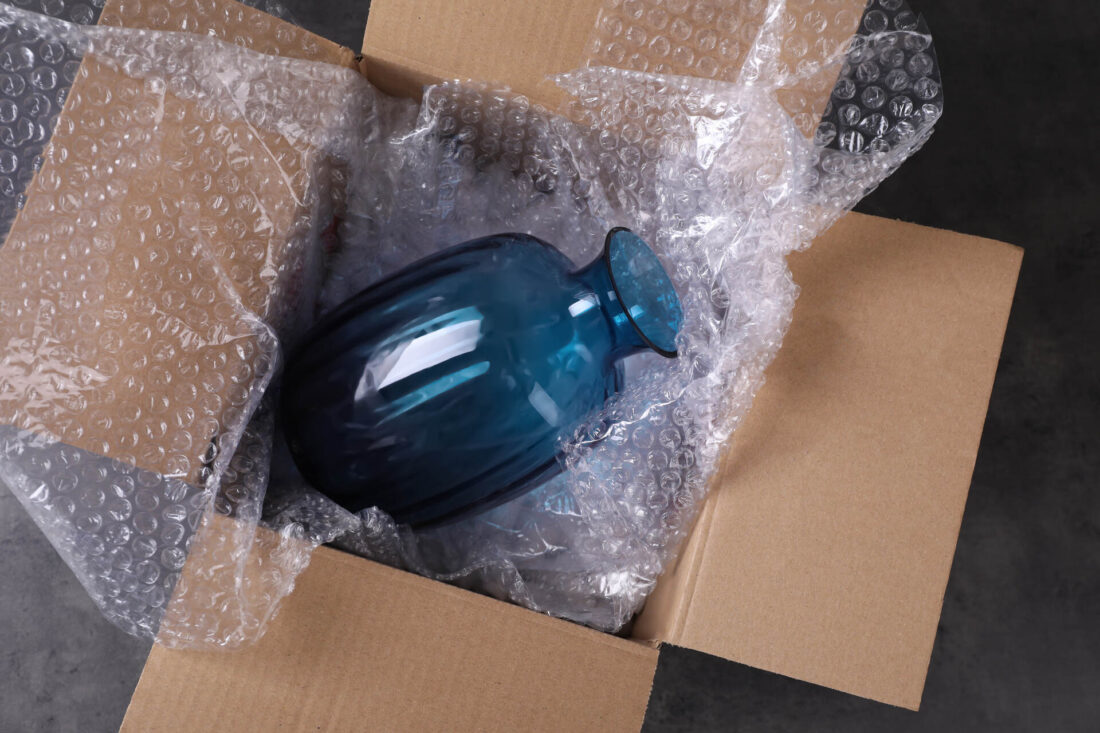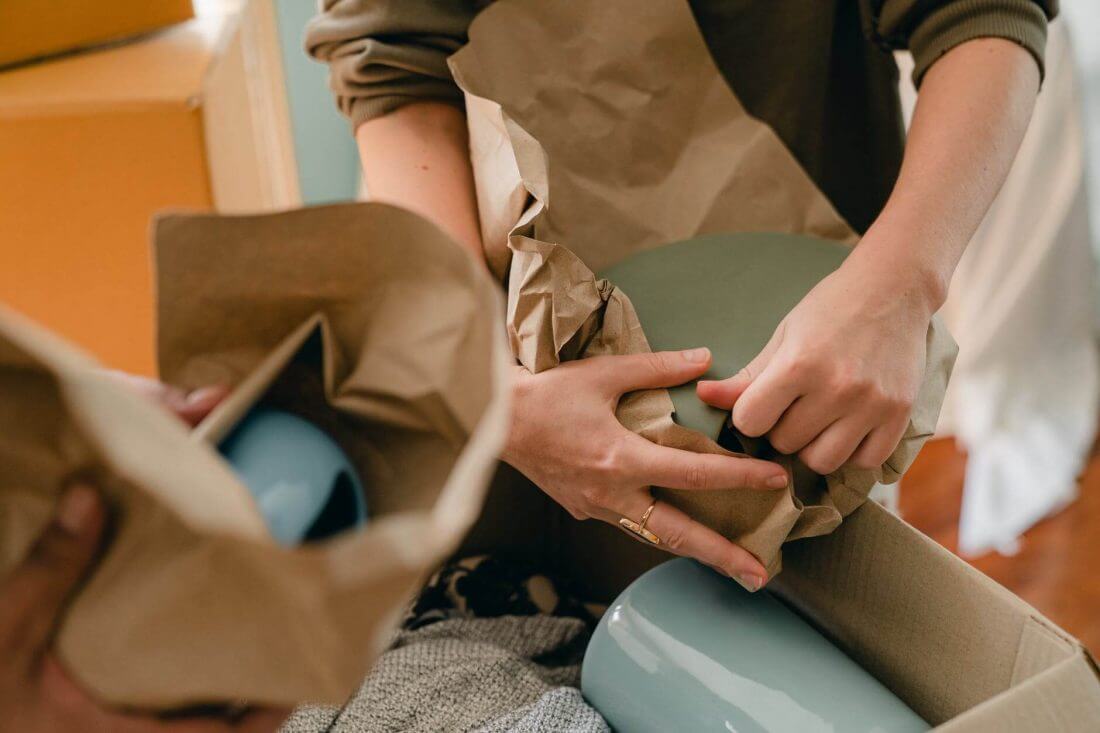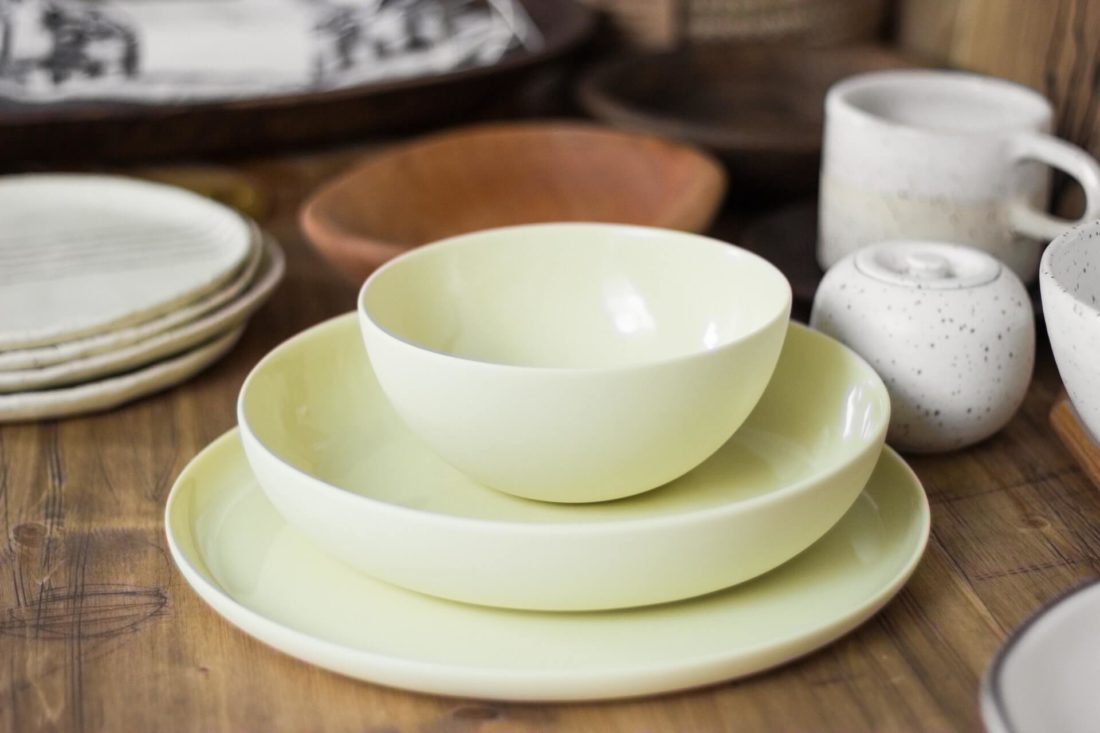Moving your home is never an easy task, but maybe the most tricky and sensitive part of that process is – packing dishes. It has a lot of steps that need to be taken seriously if you want to get everything from one place to another in one piece. There are a lot of potentially damaging situations that can occur if you are moving long-distance. Thankfully, we have prepared some handy tips to help you pack your plates, glasses, and other fragile dish items safely.


What Kind of Packaging do You Need for Moving Dishes
There are two lines of defense you are going to have to consider when preparing your glass and ceramic dishes before shipping them in a truck– the outer packaging and the padding inside the box.
Tips for Securing Your Dishes From the Outside When Moving
Using sturdy dish boxes, plastic containers, paint buckets and any other kind of durable packaging material is the safest way to transport your dishes. The outer packaging is the first barrier of security for your fragile china, plates, glasses, coffee mugs, and other easily damaged items. Your plates should lay flat in the box without much possibility of rolling over, but with just enough space to stay flatly stacked on top of each other.
The box should be approximately the same height as your glasses and mugs. Try to pack them in one row since it is the safest way to transport them. It is essential to keep the boxes with your utensils separate from the rest of the items that are being moved since heavy objects could damage your fragile possessions if they tumble during transport.
Using Wrapping Paper for Moving and Other Tips for Packing Your Dishes Inside the Dish Box
Even though dish boxes usually have separate compartments inside for each dish, that doesn’t mean they provide complete safety if they are not padded correctly. Therefore, the padding materials inside the box are your second line of defense. You can use many materials for this purpose, like bubble wrap, or packaging paper, padded divider sets, packaging foam, and packing peanuts. You can usually find them all in specialty moving stores. If you don’t pad each dish separately, there is a possibility that they will damage each other on the bumpy road during transport. The padding material you can utilize and you don’t have to pay for is your clothes – it is a free and secure padding material.
Packing Your Glasses and Mugs With the Help of Glass Wrapping Paper
Packing items like glasses and mugs is a dreary job. All the different sizes and shapes of your glasses make it hard to pack a lot of them into one box since you shouldn’t put one on top of each other. The best solution is to wrap them in paper and put a lot of packing peanuts or your old clothes in between them. Mugs might look sturdier, but they can easily chip if they bump into any other hard material. So don’t forget to enfold them in a lot of paper. You can even utilize all those newspapers that you have laying around, so as soon as you know you are going to move, start hoarding them.
Where Can I Buy Packing Paper?
If you’re wondering where to buy packing paper for moving, note that it can be purchased at a variety of stores both online and offline. Retailers like Amazon, office supply stores, home improvement stores, and packaging and shipping supply stores offer packing tissue paper
in their household supplies section. Additionally, if you want to know where to get packing paper cheaply, don’t miss visiting websites such as Freecycle, where some people may post listings with paper for packing dishes free of charge.


How to Organize Plates When Packing Dishes
The biggest predicament that you will encounter when you start boxing dishes is how to organize them. You have to make use of all the space available without overcrowding the boxes. Here are some tips on how to organize all those bulky possessions for the optimal use of space during packing.
Pack, Wrap, and Stack Every Dish Individually When Organizing Long-Distance Moving
It is time to use all those newspapers that you’ve been hoarding for your move. Wrap each plate separately and stack them on top of each other according to their size. If you pack your plates this way, you will save a lot of space. Prevent any possible damage by putting a lot of cringed paper or your clothes inside the box. Don’t forget to write FRAGILE on your boxes and ask movers to be extra careful with them. Labeling is a proper way to prevent damage as much as a tool for organizing boxes for the unpacking in your new home. Later on, you can load boxes for each room separately into the truck.


Besides Packing and Wrapping Paper, Use Carrier Bags as Much-Needed Money-Saver
Use your old carrier bags as an alternative, homemade solution. Stuff bags with bubble wrap or paper and place your less fragile utensils like pots and pans inside. They can be used as additional storage for some small, delicate items. Fill your pots with some clothes and put figurines, small picture frames, and similar things inside.
All in all, if you organize your dishes well, you have a good chance of transporting them from one place to another, all in one piece. One crucial step you should not overlook is hiring a reputable moving company such as Long Distance USA Movers that will guarantee you professional services so that all your belongings are treated safely and with care.
FAQ
What Is the Best Way to Pack Dishes for a Move?
The best way to ensure your dishes arrive safely is to use plenty of padding and sturdy boxes. First, wrap each dish individually in packing paper or bubble wrap and secure it with tape. Place a layer of padding such as foam peanuts or crumpled paper at the bottom of the box, then pack the dishes vertically, with the heaviest items at the bottom. Fill any gaps with more padding, and add a layer of padding on top of the dishes before closing the box. Label the box as “fragile” to alert cross-country movers to handle it with care. It’s also a good idea to consider using dish-specific boxes with extra reinforcement for added protection during transport.
What Materials Do I Need to Pack Dishes Safely?
To pack dishes safely for a move, you will need a few key materials to provide adequate protection. These include packing paper or bubble wrap, sturdy boxes, foam peanuts or crumpled paper for cushioning, and tape. Packing paper or bubble wrap should be used to wrap each dish individually, creating a protective layer that prevents them from touching each other and potentially chipping or breaking. Sturdy boxes are important for holding the weight of the dishes and providing structural support during transport. Foam peanuts or crumpled paper are used to fill the spaces between dishes, preventing them from shifting and bumping against each other during the move. Finally, the tape is used to secure the wrapping around each dish and to seal the box.
What Is the Best Type of Box to Use for Packing Dishes?
The best type of box to use for packing dishes is a sturdy, double-walled corrugated box that is specifically designed for relocations. These boxes are stronger than regular cardboard boxes and provide better protection against damage during transport. Dish-specific boxes with extra reinforcement, such as dividers or foam inserts, can provide even more protection. These boxes are available in a range of sizes to accommodate different dishware, from plates and bowls to glasses and mugs. When selecting boxes, be sure to choose ones that are clean, dry, and free from damage, as any weakness in the box could compromise the safety of your dishes.
How Should I Wrap Each Dish Before Placing It in the Box?
To wrap each dish before placing it in the box, start by placing a stack of packing paper or a sheet of bubble wrap on a flat surface. Center the dish on top of the paper or wrap and pull the corners of the material up and over the dish, tucking them into the center of the dish. Then, fold the sides of the material up and over the dish, securing them in place with tape. It’s important to make sure that the dish is completely covered and that no edges or corners are exposed. Repeat this process for each dish, placing them vertically in the box with the heaviest items at the bottom.
What Are the Best Ways to Fill Gaps in the Box and Prevent Dishes From Moving During Transit?
One option is to use crumpled packing paper or newspaper to fill in the spaces between the dishes. Make sure to pack the paper tightly to provide adequate cushioning and prevent shifting. Another option is to use foam peanuts, which are lightweight and easy to pour into gaps. It’s important to use enough peanuts to completely fill the space and keep the dishes in place. Bubble wrap can also be used to fill in gaps and provide additional cushioning. Be sure to test the stability of the box by gently shaking it before sealing it to ensure that the dishes are secure.
How Can I Label the Boxes to Make Unpacking Easier?
To label boxes, start by using a permanent marker to write a brief description of the contents on the top and sides of the box. Be specific about what’s inside, such as “Kitchen – Dishes” or “Living Room – Books”. If a box contains fragile items, be sure to label it as “Fragile” or “Handle with Care” to alert long-distance movers to be careful with it. It’s also a good idea to use colored labels or markers to help easily identify boxes that belong in specific rooms. Additionally, number each box and keep a master list of the contents of each box to help keep track of everything during the move.
What Are the Best Ways to Pack Delicate China and Glassware?
Start by wrapping each item individually in packing paper or bubble wrap, securing the wrapping in place with tape. Use double-walled, sturdy boxes and place a layer of cushioning such as foam peanuts or crumpled paper at the bottom of the box. Place the items vertically in the box, with the heaviest items at the bottom. Fill any gaps between the items with additional cushioning, and add a layer of cushioning on top of the items before closing the box. Label the box as “Fragile”. For extra protection, consider using dish-specific boxes with dividers or foam inserts.
What Should I Do to Protect My Dishes During Loading and Unloading?
To protect your dishes during loading and unloading, there are a few key steps you can take. First, make sure that boxes containing dishes are labeled as “Fragile” so that workers from a long-distance moving company know to handle them with care. When loading the boxes onto the truck, place them on a flat surface and stack them carefully, with heavier boxes on the bottom. Make sure that the boxes are securely stacked and not in danger of falling over. When unloading, be sure to carefully remove each box from the truck and place it on a flat surface. Avoid tossing or dropping boxes, as this can damage the contents inside. Finally, unpack dishes carefully, unwrapping each item individually and inspecting it for any damage before placing it in your new home.
How Can I Make Sure Heavy Dishes Do Not Damage Lighter Ones?
One way to do this is to pack the heavier items separately from the lighter ones. Use smaller boxes for heavier items such as pots and pans, and larger boxes for lighter items such as plates and bowls. When stacking boxes, place heavier boxes on the bottom and lighter boxes on top. It’s also important to use enough cushioning material, such as foam peanuts or crumpled paper, to prevent items from shifting and bumping against each other during transport.
What Should I Do if I Have Fragile Items, Like Teapots or Figurines, That Are Too Large to Fit in a Box?
First, wrap each item carefully in bubble wrap or packing paper and secure the wrapping in place with tape. Then, place the item in a relocation blanket and fold the blanket around the item to create a protective cocoon. Finally, secure the blanket with tape or bungee cords to hold it in place during transport. If possible, it’s also a good idea to secure the item to the side of the truck or a wall inside the truck to prevent it from shifting during the move.
What Are Some Common Mistakes to Avoid When Packing Dishes for a Move?
One common mistake is overpacking boxes, which can make them too heavy and increase the risk of damage during transport. It’s important to use the right size boxes and to pack dishes vertically, with the heaviest items at the bottom. Another mistake is not using enough cushioning material, which can lead to items shifting and bumping against each other during transport. Be sure to use enough foam peanuts, crumpled paper, or bubble wrap to fill any gaps between items and prevent movement. Finally, not labeling boxes as “Fragile” or “Handle with Care” is a mistake that can result in damage to fragile items.
How Can I Properly Pack Dishes for Storage?
Properly packing dishes for storage requires similar steps to packing them for a move. Start by wrapping each dish individually in packing paper or bubble wrap, securing the wrapping in place with tape. Use sturdy boxes and place a layer of cushioning such as packing peanuts or crumpled paper at the bottom of the box. Pack the dishes vertically, with the heaviest items at the bottom, and fill any gaps between the dishes with additional cushioning. Add a layer of cushioning on top of the dishes before closing the box. Store the boxes in a cool, dry place and avoid stacking them too high to prevent them from toppling over.
How Do I Make Sure I Have Enough Packing Materials Before I Start Packing?
A good rule of thumb is to have more materials than you think you’ll need, as it’s always better to have too much than too little. To estimate how much packing material you’ll need, take an inventory of the items you plan to pack and estimate the number of boxes you’ll need. Then, calculate the amount of packing paper, bubble wrap, foam peanuts, and tape you’ll need based on the number of boxes. Consider purchasing dish-specific boxes, wardrobe boxes, or mattress covers if necessary.
How Can I Reduce the Risk of Breakage During the Moving Process?
Use sturdy boxes and pack each item individually in packing paper or bubble wrap, securing the wrapping in place with tape. Use plenty of cushioning material to fill any gaps between items and prevent them from shifting during transport. Label boxes as “Fragile” and try to place heavier boxes on the bottom and lighter boxes on top. During unloading, carefully remove boxes from the truck and place them on a flat surface, avoiding tossing or dropping them.
How Can I Pack Dishes in a Way That Is Efficient and Space-Saving?
Start by using dish-specific boxes or other sturdy boxes that are the right size for the dishes you’re packaging. Wrap each dish individually in packing paper or bubble wrap, securing the wrapping in place with tape. Place a layer of cushioning material at the bottom of the box and place dishes vertically, with the heaviest items at the bottom, and fill any gaps between the dishes with additional cushioning. Add a layer of cushioning on top of the dishes before closing the box. It’s also a good idea to pack small items inside larger items, such as placing bowls inside larger pots, to maximize space. By packing dishes in this way, you can help ensure that they arrive at your new home safely while also making the most of the available space.
What Is the Best Way to Pack Silverware and Other Utensils?
One efficient way to pack them is to use a utensil tray or organizer inside a box. Wrap the tray or organizer in packing paper or bubble wrap to protect it during transport. Then, place the silverware and utensils in the tray, securing any loose items with rubber bands or twist ties. Place the tray or organizer in the box, and fill any gaps with additional cushioning material and label the box with a description of the contents and the room where it belongs.
How Can I Pack Dishes in a Way That Makes Unpacking and Organizing Easy?
Be specific about the box contents, such as “Kitchen – Plates” or “Dining Room – Crystal Glasses.” Pack dishes vertically, with the heaviest items at the bottom, and use sturdy, double-walled boxes. Fill any gaps between the dishes with cushioning material to prevent them from shifting during transport. Use dish-specific boxes with dividers or foam inserts, if necessary, to keep dishes organized and separated. Consider grouping similar items together in the same box, such as all plates or all glasses. Finally, create a master list of the contents of each box to help keep track of everything during the move. In the end, you can always consider getting cross-country moving services to help you with the packaging task.
How Do I Ensure That My Dishes Are Properly Packed for a Long-Distance Move?
Properly packing dishes for a long-distance move requires extra care to ensure that they arrive at your new home without damage – if you don’t want to get long-distance moving services for this task. Start by using sturdy boxes specifically designed for relocating, along with cushioning materials. Wrap each dish individually and secure the wrapping in place with tape. Label each box as “Delicate” or “Fragile”. It’s also important to use a reputable long-distance moving company with experience in cross-country moves and to verify that they have the proper insurance to cover any potential damage during transport.
What Should I Do With Leftover Packing Materials After the Move?
After the move, you may have leftover packing materials that you’re not sure what to do with. A good way to dispose of these materials is to recycle them, if possible. Check with your local recycling program to find out how to properly dispose of these items. If the materials are still in good condition, you could also consider donating them to a friend, or neighbor, or listing them online. Alternatively, you could keep the materials for future use, such as for storage or for another move down the road.
How Can I Make Sure My Dishes Arrive Safely at the New Location?
Start by using sturdy boxes and packing each dish individually. Use cushioning material, such as packing peanuts or crumpled paper, to fill any empty space between items and prevent them from shifting during transport. Label each clearly so everybody knows they contain delicate items. When loading the truck, place heavier boxes on the bottom and lighter boxes on top, and secure the boxes. During unloading, carefully remove boxes from the truck and find a flat surface to place them on. Finally, unpack dishes carefully, unwrapping each item individually and inspecting it for any damage.






